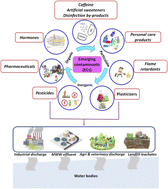Alternative methods of monitoring emerging contaminants in water: a review†
Abstract
Anthropogenic activities have steadily increased the release of emerging contaminants (ECs) in aquatic bodies, and these ECs may have adverse effects on humans even at their trace (μg L−1) levels. Their occurrence in wastewater systems is more common, and the current wastewater treatment facilities are inefficient in eliminating many of such persistent ECs. “Gold standard” techniques such as chromatography, mass spectrometry, and other high-resolution mass spectrometers are used for the quantification of ECs of various kinds, but they all have significant limitations. This paper reviews the alternative methods for EC detection, which include voltammetry, potentiometry, amperometry, electrochemical impedance spectroscopy (EIS) based electrochemical methods, colorimetry, surface-enhanced Raman spectroscopy (SERS), fluorescence probes, and fluorescence spectroscopy-based optical techniques. These alternative techniques have several advantages over conventional techniques, including low sample volume, excludes solid phase extraction procedure, high sensitivity, selectivity, portability, reproducibility, rapidity, low cost, and the ability to monitor ECs in real time. This review summarises each of the alternative methods for detecting ECs in water samples and their respective limits of detection (LODs). The sensitivity of each technique varied depending on the type of EC measured, type of electrochemical probe and electrode, substrates, type of nanoparticle (NP), the physicochemical parameters of water samples tested, and more. Nevertheless, this paper also focuses on some of the current challenges encountered by these alternative methods in monitoring ECs.



 Please wait while we load your content...
Please wait while we load your content...